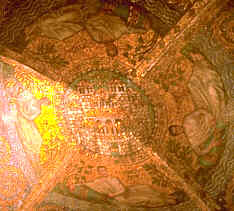


If you are looking at this page without frames, there is more information about medieval writing to be found by going to the home page (framed) or the site map (no frames).
| The Classical Legacy (2) | ||
| The question remains, what were they used for? The general opinion of scholars seems to be that Latin Classical works were in monastic libraries not so much for the acquisition of knowledge from Classical scholarship, but for the learning of Latin. Latin was the international language of the medieval church. It was not only the language of liturgy, it was the language of theology, philosophy and intellectual debate. Monks not only copied Latin works, they created their own discourses in the language. They also taught the language to others in schools. The finest exemplars of the ancient language served to educate monks and their students in full and elegant Latin literacy. | ||
 |
In the Carolingian era, books were produced of metrical florilegia. These were collections of lines of Latin verse which were selected because they provided exemplars for the scansion of Latin poetry. These collections included samples from both pagan Classical and Christian verse. The criterion for selection was their poetic and literary quality rather than their content or religious philosophy. | |
| The golden mosaic ceiling of Charlemagne's Palatine Chapel in Aachen contains samples of Classical art style in the reclining figures which surround the representation of the church in the central medallion. | ||
| Up to the 12th century manuscripts were assembled from the works of several authors, with Classical and Christian authors mixed together in volumes dictated by subject; grammatical texts, poetry, rhetoric or dialectic. Texts of Classical origin specifically devoted to Latin grammar were reproduced. | ||
 |
||
| A small sample from a 9th century copy of Priscian's Latin Grammar (Leiden University Library, Cod. Lat. 67). (From New Palaeographical Society 1904) | ||
| Many books were heavily glossed, indicating their use as classroom texts. It is not uncommon to find texts in which the gloss is in the same scribal hand as the main text, indicating that the lessons already learned have been passed on by transcription to a new edition of the manuscript. | ||
| The production of copies of the works of Classical authors evidently slowed somewhat in the 12th century. Teaching libraries may have been relatively well stocked by this time. School teaching also tended to move away from the monasteries to institutions run by secular clergy. A speciality of the 12th century were florilegia and epitomes. These compendia of extracts allowed the deletion of passages which were at odds with current moral or religous beliefs while reproducing those aspects which had value; a sort of medieval Reader's Digest. | ||
| While the Latin Classics may have been studied largely for their literary qualities, certain works of the Greek Classics entered into medieval thinking. The works of Plato and Aristotle were known to medieval readers through Latin translations. Aspects of these ancient philosophies became woven and entangled through medieval theology and moral philosophy. They informed robust debate among church thinkers that reached its most energetic state among the prolific writers and philosophers of the 12th century. | ||
| Columbia University displays a leaf from a 13th century English version of some of the works of Aristotle (Plimpton MS 21, f.73v) and well as a 14th century French copy of Aristotle's Opera Logica, complete with historiated initial and glosses to the text (X88/Ar512, f.208v). The Bodleian Library shows the full manuscript of a 12th century French copy of Plato's Timaeus in Latin translation with diagrams and glosses. Once again, the individual page enlargements are huge and heavy on download time. | ||
 |
In 15th century Italy there was a movement for rediscovering the Classical past, or perhaps reinventing it, which we dignifiy with the label Renaissance. The works of Classical authors were rediscovered, in some cases after centuries long trips around the monasteries of Europe and back to their homeland. Exquisite manuscripts were produced using scripts resurrected from Classical antiquity, or the monastic scriptoria of 9th century France and Germany. The Greek Classics also got the reinvigorating treatment, in translated editons. The wheel of cultural fortune acted more like the agitator of a washing machine, brightening and renovating recycled old words. | |
| Leaf from a mid 15th Italian language century copy of the Ethics of Aristotle, with historic connections to the royal family of Sicily (British Library, add ms 21120, f.1). The first page has text in rustic capitals surrounded by ornate coloured and gold ornament in Italianate style. (From New Palaeographical Society 1908) | ||
|
|
||
|
|
||
|
If you are looking at this page without frames, there is more information about medieval writing to be found by going to the home page (framed) or the site map (no frames). |
||